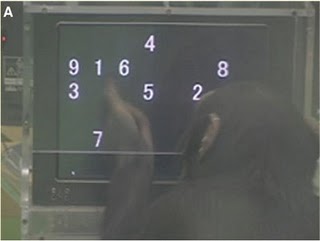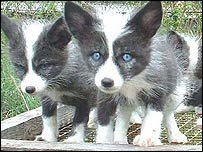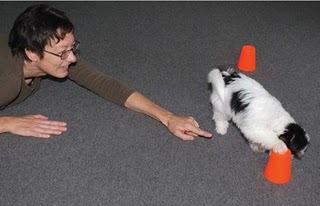 In my last post I summed up some proposals for what (among other things) makes human cognition unique. But one thing that we should bear in mind, I think, is that our cognitive style may more be something of an idiosyncrasy due to a highly specific cognitive specialization instead of a definitive quantitative and qualitative advance over other styles of animal cognition. In this post I will look at studies which further point in that direction.
In my last post I summed up some proposals for what (among other things) makes human cognition unique. But one thing that we should bear in mind, I think, is that our cognitive style may more be something of an idiosyncrasy due to a highly specific cognitive specialization instead of a definitive quantitative and qualitative advance over other styles of animal cognition. In this post I will look at studies which further point in that direction.

Chimpanzees, for example, beat humans at certain memory tasks (Inoue & Matsuzawa 2007) and behave more rational in reward situations (Jensen et al. 2007).
In addition, it has been shown that in tasks in the social domain, which are generally assumed to be cognitively complex, domesticated animals such as dogs and goats (Kaminski et al. 2005) fare similarly well or even outperform chimpanzees.
Social Cognition and Self-Domestication
It is entirely possible that the first signs of human uniqueness where at first simply side-effects our self-domesticating lifestyle – the same way the evolution of social intelligence in dogs and goats is hypothesised to have come about –, acting on a complex primate brain (Hare & Tomasello 2005).
 This line of reasoning is also supported by domesticated silver foxes which have been bred for tameness over a time period of 50 years but developed other interesting characteristics as a by-product: To quote from an excellent post on the topic over at a Blog Around the Clock (see also here):
This line of reasoning is also supported by domesticated silver foxes which have been bred for tameness over a time period of 50 years but developed other interesting characteristics as a by-product: To quote from an excellent post on the topic over at a Blog Around the Clock (see also here):
“They started having splotched and piebald coloration of their coats, floppy ears, white tips of their tails and paws. Their body proportions changed. They started barking. They improved on their performance in cognitive experiments. They started breeding earlier in spring, and many of them started breeding twice a year.”

What seems most interesting to me, however, is another by-product of their experimental domestication: they also improved in the domain of social cognition. For example, like dogs, they are able to understand human communicative gestures like pointing. This is all the more striking because, as mentioned above, chimpanzees do not understand human communicative gestures like helpful pointing. Neither do wolves or non-domesticated silver foxes (Hare et al. 2005).
Continue reading “What Makes Humans Unique ?(III): Self-Domestication, Social Cognition, and Physical Cognition”



